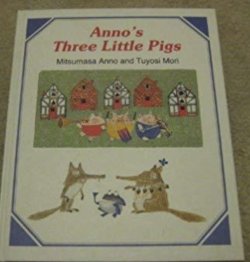Gareth B. Matthews

Review of Socrates and the Three Pigs by Mitsumasa Anno and Tuyosi Mori (New York: Philomel Book, 1986). Originally published in Thinking: The Journal of Philosophy for Children 13(3): 4.
Socrates is a wolf who likes to talk about happiness with his friend, Pythagoras, who is a frog, and to reflect on whether the three pigs playing near his den are really happy. Socrates’s wife, Xanthippe, who is hungry, asks, ‘When are we going to eat?” So, Socrates turns his thoughts to whether he can catch one of the three little pigs for dinner.
By this time, it is dark. The pigs are in bed. But in which of the five houses before him should Socrates look for them? Being an orderly thinker, Socrates thinks about the pigs one at a time. Pig A could be in house 1, or in house 2, or in house 3, or in house 4, or in house 5. Suppose Pig A were in house 1. Pig B could be there, too, or else pig B could be in house 2 or (etc. for each of the five houses). Suppose both pig A and pig B were in house 1; pig C might be there as well, or in 2 (etc.)
Luckily, Pythagoras, the frog, is a mathematician. He explains to his friend, Socrates, that the possible sleeping arrangements for A, B, and C, are five times five times five, that is,
125. Pythagoras also explains that one can think of these possibilities as a branching tree: the five main limbs off the trunk can represent the five possible locations of pig A The five limbs off each of the first set can represent the five possible locations of pig B, given each of the five possible locations of pig A The five twigs off each of the 25 secondary branches could represent the five possible locations of pig C, given the 25 possible configurations of A and B.
Anno’s delightfully illustrated book shows each of these 125 arrangements in the row of five houses. It also shows a branching tree to illustrate the idea of branching 2 possibilities. The curious reader can figure out various ways of making sure that all the possibilities have really been exhausted.
Meantime, Xanthippe has become impatient with all this speculation. “It’s dark,” she protests; ‘you won’t be able to tell the pigs apart and, anyway, it doesn’t matter which pig you catch.” “A good point,” replies Socrates; “we’ll color all the pigs gray.”
On the next page the 125 arrangements are “grayed out” in such a way that the pigs are now indistinguishable from each other. Inspection reveals many repetitions. Although only one gray pattern has, for example, all three pigs in house 1, three arrangements have two pigs in house 1 and one pig in house 2. That is because house 1 might contain A and B, or A and C, or B and C, with, in each case, the third pig going to house 2. The reader is left to figure out which gray patterns are repeated, and why.
“Suppose each house can hold just one little pig,” suggests Socrates; “now let’s see how many possibilities there are.” This time it is the rows of five houses that are arranged in branching order. Suppose pig A is in house 1; then four possibilities are left for B. Suppose A is in 1 and B is in 2; then three possibilities are left for C. And so on. Again, Pythagoras discusses this tree of possibilities. Five (primary limbs) times four (smaller limbs) times three (twigs) equals 60, the total number of twigs, and also the total number of possibilities, given the assumption that each pig is in one of the four houses and no two pigs are in the same house.
Socrates’s ruminations, egged on by Pythagoras, go on, and on, all through the night. In the morning the pigs come out to frolic on the grass. “How happy they look!” exclaims Socrates. Oddly, Xanthippe says she is not hungry anymore. Socrates suggests making friends with the pigs. And they do. This story includes, at the very end, a solemn note on combinatorial analysis for “parents and other older readers.” It makes obvious the pedagogical aims Mitsumasa Anno and his mathematician collaborator, Tuyosi Mori, had in writing their story.
Nevermind, the story is fun. To be sure, Xanthippe plays the stereotypically feminine role of fixating on the meal and being unable, herself, to bring home the bacon. Moreover, Socrates isn’t allowed to have any interesting thoughts about happiness and Pythagoras, the frog, isn’t made to say anything about the vegetarianism espoused by the great mathematician and philosopher whose name he bears.
Still, it is fun to think about combinatorial possibilities. The wonderful illustrations in this book greatly enhance the fun. They also set the stage for further thoughts about possibility and probability. Does the mere fact that we have no information about pig A’s preferences in architecture make it just as likely that A will be bedded down in house 1, which is Tudor, as it is she will be in house 2, which is Georgian? Do we think that it is just as likely B would share a house with C as it is, she would share a house with A because we don’t know what B knows, namely, that C snores?
“But we were ignoring all those accidental facts about these particular pigs and houses,” someone may protest; “we were just considering pure possibilities.”
“Then does the mathematics of combinatorial analysis have anything to do with real probabilities?” someone may want to know. Let the philosophy begin!
